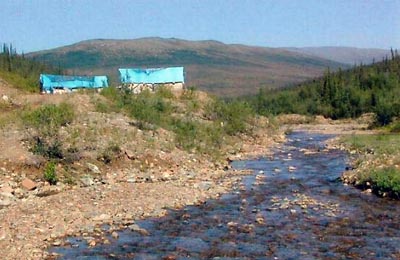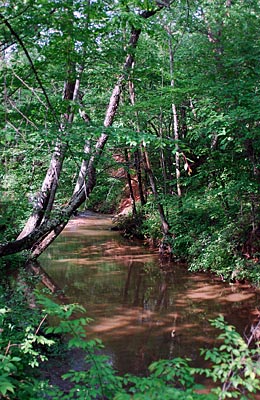Claim Filing FYI
Note: Special Thanks to a fellow GPAA member Boxy, for providing this detailed information on Filing, and taking care of your claim.He first shared this in a post on the main GPAA forum, and with his permission, it's reprinted here.
If people understood what a claim is and how to properly file one there would be a lot fewer complaints about the BLM and over filing. I see a lot of over filing and a lot of improperly filed claims. Let's see if we can't dispel some of the myths about claims that I read on forums and all over the internet.
Myth:
Claims are recorded at the BLM.Fact:
Claims are recorded at the county recorder's office. The BLM requires an informational notice when a mineral claim is made, this is only so they will know if someone has a superior right to THEM when they want to administer the surface estate (non-mineral).If you have not recorded your claim to the mineral estate of a particular described area with the county recorder you should not be filing with the BLM. Some BLM offices are now requiring that you provide the book and page number or registration number from the county recorder BEFORE they will accept your information filing.
Myth:
If the County Recorder and the BLM accept my claims fees I have a valid claim.Fact:
Neither the County Recorder nor the BLM are responsible for making sure your claim is valid. You are the only one that is responsible for making sure your claim is valid and lawful. You must do your own due dilligence.
Myth:
If I have a copy of my BLM filing papers I have proof of a prior claim should someone else file over my claim.Fact:
Only a CERTIFIED copy of the original claim filing with the County Recorder is proof of claim. The sheriff is most likely going to go with the person with a certified copy over a BLM copy if it comes to a dispute ON the claim. A certified copy always trumps the BLM filing in a court of record.Myth:
If the BLM doesn't show any claims on the LR2000 the area is open to claiming.Fact:
The BLM is not an authority on where claims are located. Read the disclaimer that is on the bottom of every page of every LR2000 report. The BLM only provides the information filed with them, many of these filings are wrong. They only provide the location to the nearest quarter section (160 acres). They are often wrong and may be off by several sections (miles). If a 10 acre claim straddles the corner or center of a section it is recorded as covering the entire 640 acres. Sometimes their records are weeks, months or even years out of date.Myth:
If an area is not claimed then I can legally claim it.Fact:
Not all areas are open to mineral claims. Even if an area is open to mineral claims you must first DISCOVER a valuable mineral resource. Without first making a discovery your claim is not legally valid. Not all minerals are claimable even if they are valuable.Myth:
If I find a claim that was not properly filed I can just file over it.Fact:
If you feel a claim has been misfiled or is no longer active you can file an adverse claim. You will then have 60 days to begin a suit for possession at the county courthouse (most States). You must serve legal notice on the prior claimant in a timely manner and actually prosecute your claim in court. Failure to do any of these things makes your claim null and void ab inito (your claim never existed under the law).Myth:
If there are no markers or corner posts there is no valid claim.Fact:
State law controls what is a valid means of posting a claim. I don't know all of the State's law regarding posting but I haven't seen one yet that requires that posts or monuments be maintained after a claim is recorded. It is your responsibility to know the legal status of land you may be considering prospecting. This includes ownership of the surface and subsurface (mineral) estate. Land and Mineral Trespass are crimes, you can be jailed and fined (or worse in some mining areas).
Myth:
If I make a claim I can use it for recreation.Fact:
There is no such thing as recreational mining on a mineral claim. You are either mining for valuable minerals (prudent man rule) or you are NOT MINING. The surface estate of your claim is usually open to all persons who wish to recreate. This includes camping, swimming, hiking, playing games, cooking or any of the many recreational activities people enjoy on public lands. You may not restrict other's recreational activities on your claim. You have an equal right to recreate on your claim. If you persist in portraying your claim's mining activities as "recreational" you may be leaving your mineral claim open to challenge by any adverse claimant who can prove your "recreational" intent (i.e. posting on a public forum).If you are interested in making a claim first find an area that is open to mineral entry and may have discoverable valuable minerals. Once you've defined the area you are interested in go to the County Recorder and get a copy of all the claims filed in that area. Plot those claims on a topo map of the area. If there is unclaimed land go there and prospect that land for valuable minerals. When you have discovered a valuable mineral deposit post, monument, describe and map that claim. Record the claim with the County Recorder, get extra certified copies. Take a copy of the recorded claim to the BLM and make an informational filing. Mine your claim and enjoy your gold. Keep your filings current, pay your fees, and defend your claim.
The best thing you can do to make sure your claim is valid and to keep your claim is to read and understand the mining law. You can find complete copies HERE
If this seems like a lot of work then you have been paying attention. If this seems like too much work or you are just interested in recreational mining - join a club. They have already done all of this for their members.
Boxy - Gpaa Forum Oldtimer
